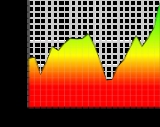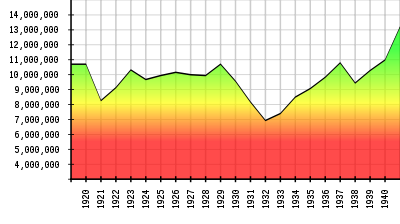
Recession of 1937
Encyclopedia
The Recession of 1937–1938 was a temporary reversal of the pre-war 1933 to 1941 economic recovery from the Great Depression in the United States
.
rolls were drastically cut and PWA
projects were slowed to a standstill. The American economy took a sharp downturn in mid-1937, lasting for 13 months through most of 1938. Industrial production declined almost 30 per cent and production of durable good
s fell even faster.
Unemployment jumped from 14.3% in 1937 to 19.0% in 1938. Manufacturing output fell by 37% from the 1937 peak and was back to 1934 levels.
Producers reduced their expenditures on durable goods, and inventories declined, but personal income was only 15% lower than it had been at the peak in 1937. In most sectors, hourly earnings continued to rise throughout the recession, which partly compensated for the reduction in the number of hours worked. As unemployment rose, consumers' expenditures declined, leading to further cutbacks in production.
 The Roosevelt Administration reacted by launching a rhetorical campaign against monopoly power, which was cast as the cause of the depression, and appointing Thurman Arnold
The Roosevelt Administration reacted by launching a rhetorical campaign against monopoly power, which was cast as the cause of the depression, and appointing Thurman Arnold
in the anti-trust division
of the U.S. Department of Justice to act, but Arnold was not effective. In February 1938, Congress passed a new AAA bill which authorized crop loans, crop insurance against natural disasters, and large subsidies to farmers who cut back production. On April 2, Roosevelt sent a new large-scale spending program to Congress, and received $3.75 billion which was split among PWA, WPA, and various relief agencies. Other appropriations raised the total to $5 billion in the spring of 1938, after which the economy recovered.
Some economists believed that banking reforms already enacted were insufficient and that further reforms were warranted. Many suggestions put forward by Chicago economists in two 1933 memoranda that came to be known as the Chicago plan
, were resurrected and recirculated in a 1939 draft proposal entitled A Program for Monetary Reform
.
in late 1941. Personal income in 1939 was almost at 1919 levels in aggregate, but not per capita. The farm population had fallen 5%, but farm output was up 19% in 1939.
Employment in private sector factories regained the levels reached in 1929 and 1937, but did not exceed them until the onset of the war, and manufacturing employment leaped from 11 million in 1940 to just over 18 million in 1943. Productivity steadily increased, and output in 1942 was well above the levels of both 1929 and 1937.
assign blame to cuts in federal spending and increases in taxes at the insistence of the US Treasury, while monetarists
, most notably Milton Friedman
, assign blame to the Federal Reserve's tightening of the money supply in 1936 and 1937. Johnathan Catalan, an Austrian school
adherent, assigns blame to the relatively large expansion of the money supply from 1933 to 1937. He also pointed out that the money supply didn't tighten until after the recession began. It is also worth mentioning that cannabis prohibition was enacted in 1937, killing off all jobs in the hemp industry, which only made a temporary comeback during the WWII "Hemp for Victory" campaign.
Great Depression in the United States
The Great Depression began with the Wall Street Crash of October, 1929 and rapidly spread worldwide. The market crash marked the beginning of a decade of high unemployment, poverty, low profits, deflation, plunging farm incomes, and lost opportunities for economic growth and personal advancement...
.
Background
By the spring of 1937, production, profits, and wages had regained their 1929 levels. Unemployment remained high, but it was considerably lower than the 25% rate seen in 1933. In June 1937, some of Roosevelt's advisors urged spending cuts to balance the budget. WPAWorks Progress Administration
The Works Progress Administration was the largest and most ambitious New Deal agency, employing millions of unskilled workers to carry out public works projects, including the construction of public buildings and roads, and operated large arts, drama, media, and literacy projects...
rolls were drastically cut and PWA
Public Works Administration
The Public Works Administration , part of the New Deal of 1933, was a large-scale public works construction agency in the United States headed by Secretary of the Interior Harold L. Ickes. It was created by the National Industrial Recovery Act in June 1933 in response to the Great Depression...
projects were slowed to a standstill. The American economy took a sharp downturn in mid-1937, lasting for 13 months through most of 1938. Industrial production declined almost 30 per cent and production of durable good
Durable good
In economics, a durable good or a hard good is a good that does not quickly wear out, or more specifically, one that yields utility over time rather than being completely consumed in one use. Items like bricks or jewellery could be considered perfectly durable goods, because they should...
s fell even faster.
Unemployment jumped from 14.3% in 1937 to 19.0% in 1938. Manufacturing output fell by 37% from the 1937 peak and was back to 1934 levels.
Producers reduced their expenditures on durable goods, and inventories declined, but personal income was only 15% lower than it had been at the peak in 1937. In most sectors, hourly earnings continued to rise throughout the recession, which partly compensated for the reduction in the number of hours worked. As unemployment rose, consumers' expenditures declined, leading to further cutbacks in production.
Response

Thurman Arnold
Thurman Wesley Arnold was an iconoclastic Washington, D.C. lawyer. He was best known for his trust-busting campaign as Assistant Attorney General in charge of the Antitrust Division in Franklin Delano Roosevelt's Department of Justice from 1938 to 1943...
in the anti-trust division
United States Department of Justice Antitrust Division
The United States Department of Justice Antitrust Division is responsible for enforcing the antitrust laws of the United States. It shares jurisdiction over civil antitrust cases with the Federal Trade Commission and often works jointly with the FTC to provide regulatory guidance to businesses...
of the U.S. Department of Justice to act, but Arnold was not effective. In February 1938, Congress passed a new AAA bill which authorized crop loans, crop insurance against natural disasters, and large subsidies to farmers who cut back production. On April 2, Roosevelt sent a new large-scale spending program to Congress, and received $3.75 billion which was split among PWA, WPA, and various relief agencies. Other appropriations raised the total to $5 billion in the spring of 1938, after which the economy recovered.
Some economists believed that banking reforms already enacted were insufficient and that further reforms were warranted. Many suggestions put forward by Chicago economists in two 1933 memoranda that came to be known as the Chicago plan
Chicago plan
The Chicago plan was a collection of banking reforms suggested by University of Chicago economists in the wake of the Great Depression. A six-page memorandum on banking reform was given limited and confidential distribution to about 40 individuals on March 16, 1933. The plan was supported by such...
, were resurrected and recirculated in a 1939 draft proposal entitled A Program for Monetary Reform
A Program for Monetary Reform
A Program for Monetary Reform is a July 1939 first draft proposal to repair and rebuild the American economic system following the Great Depression which began with the sudden, devastating collapse of US stock market prices on October 29, 1929, known as Black Tuesday and after apparent recovery in...
.
Recovery
Although the American economy recovered in mid-1938, employment did not regain the 1937 level until the United States entered World War IIWorld War II
World War II, or the Second World War , was a global conflict lasting from 1939 to 1945, involving most of the world's nations—including all of the great powers—eventually forming two opposing military alliances: the Allies and the Axis...
in late 1941. Personal income in 1939 was almost at 1919 levels in aggregate, but not per capita. The farm population had fallen 5%, but farm output was up 19% in 1939.
Employment in private sector factories regained the levels reached in 1929 and 1937, but did not exceed them until the onset of the war, and manufacturing employment leaped from 11 million in 1940 to just over 18 million in 1943. Productivity steadily increased, and output in 1942 was well above the levels of both 1929 and 1937.
Interpretations
Economists disagree about the causes of this downturn. Keynesian economistsKeynesian economics
Keynesian economics is a school of macroeconomic thought based on the ideas of 20th-century English economist John Maynard Keynes.Keynesian economics argues that private sector decisions sometimes lead to inefficient macroeconomic outcomes and, therefore, advocates active policy responses by the...
assign blame to cuts in federal spending and increases in taxes at the insistence of the US Treasury, while monetarists
Monetarism
Monetarism is a tendency in economic thought that emphasizes the role of governments in controlling the amount of money in circulation. It is the view within monetary economics that variation in the money supply has major influences on national output in the short run and the price level over...
, most notably Milton Friedman
Milton Friedman
Milton Friedman was an American economist, statistician, academic, and author who taught at the University of Chicago for more than three decades...
, assign blame to the Federal Reserve's tightening of the money supply in 1936 and 1937. Johnathan Catalan, an Austrian school
Austrian School
The Austrian School of economics is a heterodox school of economic thought. It advocates methodological individualism in interpreting economic developments , the theory that money is non-neutral, the theory that the capital structure of economies consists of heterogeneous goods that have...
adherent, assigns blame to the relatively large expansion of the money supply from 1933 to 1937. He also pointed out that the money supply didn't tighten until after the recession began. It is also worth mentioning that cannabis prohibition was enacted in 1937, killing off all jobs in the hemp industry, which only made a temporary comeback during the WWII "Hemp for Victory" campaign.

